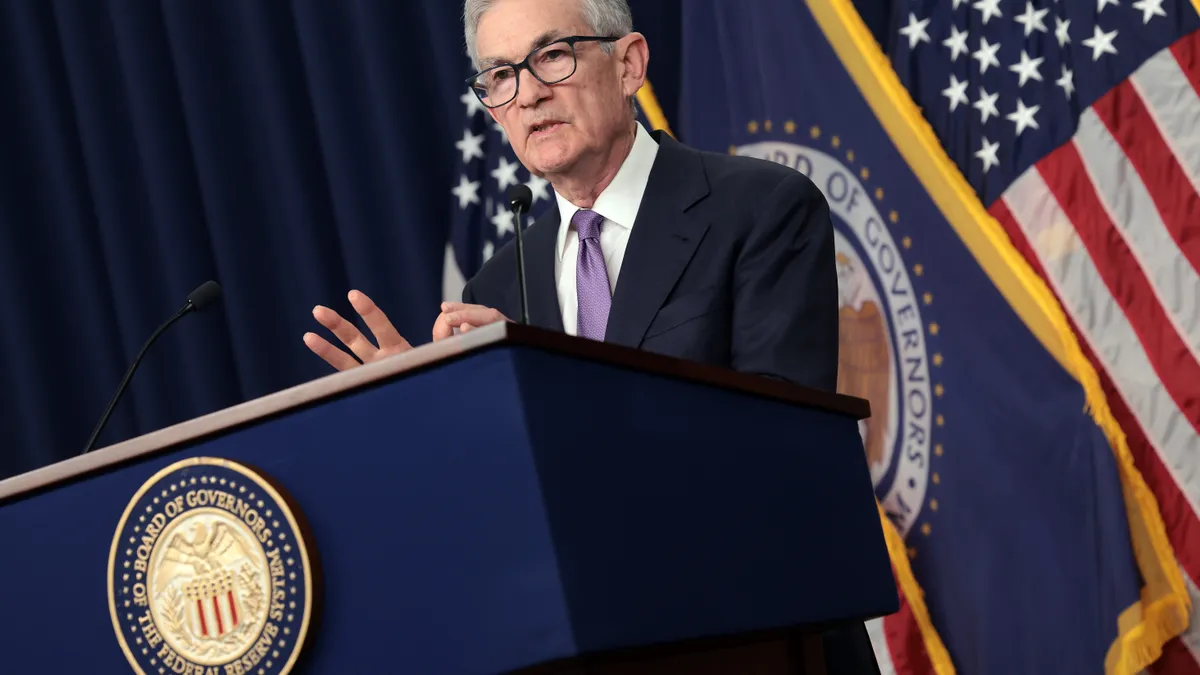Dive Brief:
- The Federal Reserve on Wednesday forecast reductions in the federal funds rate this year totaling 0.75 percentage point and held the main interest rate at a 23-year high for the fifth consecutive meeting.
- The central bank will likely trim the federal funds rate by the end of 2024 to 4.6% from the current range between 5.25% and 5.5%, according to a median projection by Fed officials. Their projection matched the level forecast in December.
- The Fed’s preferred inflation gauge — the core personal consumption expenditures price index — will probably fall by the end of 2024 to 2.6% from a 2.8% annual rate in January, according to Fed officials’ median projection. They forecast that unemployment will likely rise to 4% at the end of this year compared with 4.1% in their December projection. The jobless rate last month was 3.9%.
Dive Insight:
Inflation edged up during January and February after falling steadily for much of last year, reinforcing caution among policymakers who want to see more easing in price pressures before cutting the main interest rate and starting to reverse the most aggressive tightening in 40 years.
The core consumer price index, which excludes volatile food and energy prices, increased 0.4% last month from January and 3.2% on an annual basis, well above the Fed’s 2% target.
Services prices, which shift more slowly than other inflation components, gained 0.5% during February and 5.2% over 12 months, with a 0.4% increase in shelter costs the biggest driver of services inflation, according to the Labor Department.
The higher inflation data during the first two months of 2024 “haven’t really changed the overall story, which is that of inflation moving down gradually on a sometimes bumpy road toward 2%,” Powell said during a press conference.
The persistence of inflation has pushed back by several weeks market expectations for a cut in the federal funds rate.
In December, traders in interest rate futures set a high probability that the Fed would begin trimming rates today and make a total of six quarter-point reductions by the end of 2024. They now see June 12 as the most likely date for the initial rate cut, according to the CME FedWatch Tool.
Powell reiterated that policymakers need to walk a narrow path when timing the first rate cut in the current monetary policy cycle.
“If we ease too much or too soon, we could see inflation come back,” he said. “If we ease too late, we could do unnecessary harm to employment and people’s working lives.”
The policy-setting Federal Open Market Committee is not yet ready to trim borrowing costs, Powell said.
“The committee wants to see more data that gives us higher confidence that inflation is moving down sustainably toward 2%,” he said. “We don’t see this in the data right now.”
“In the meantime, the economy is strong, the labor market is strong, inflation has come way down and that gives us the ability to approach this question carefully,” Powell said.
The economy, although cooling after strong growth during the second half of 2023, is showing signs of steady expansion. During the first quarter of this year, gross domestic product will probably increase at a 2.1% annual rate, the Atlanta Fed said in a forecast Tuesday.
Fed officials predicted that the economy will grow 2.1% this year compared with their 1.4% projection in December. They also slightly upgraded to 2% their growth forecasts for both next year and 2026.
The central bank will likely cut the federal funds rate to 3.9% next year and to 3.1% in 2025, according to median projections by Fed officials.
Core PCE inflation will decline to 2.2% by the end of next year and to 2% by 2026, they forecast, matching their December projections.












